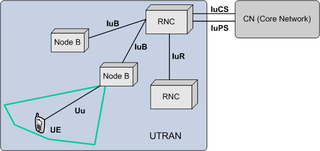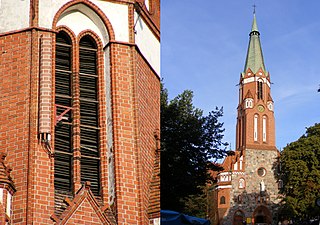Related Research Articles

General Packet Radio Service (GPRS), also called 2.5G, is a packet oriented mobile data standard on the 2G cellular communication network's global system for mobile communications (GSM). GPRS was established by European Telecommunications Standards Institute (ETSI) in response to the earlier CDPD and i-mode packet-switched cellular technologies. It is now maintained by the 3rd Generation Partnership Project (3GPP).
The Universal Mobile Telecommunications System (UMTS) is a third generation mobile cellular system for networks based on the GSM standard. Developed and maintained by the 3GPP, UMTS is a component of the International Telecommunication Union IMT-2000 standard set and compares with the CDMA2000 standard set for networks based on the competing cdmaOne technology. UMTS uses wideband code-division multiple access (W-CDMA) radio access technology to offer greater spectral efficiency and bandwidth to mobile network operators.
Non-access stratum (NAS) is a functional layer in the NR, LTE, UMTS and GSM wireless telecom protocol stacks between the core network and user equipment. This layer is used to manage the establishment of communication sessions and for maintaining continuous communications with the user equipment as it moves. The NAS is defined in contrast to the Access Stratum which is responsible for carrying information over the wireless portion of the network. A further description of NAS is that it is a protocol for messages passed between the User Equipment, also known as mobiles, and Core Nodes that is passed transparently through the radio network. Examples of NAS messages include Update or Attach messages, Authentication Messages, Service Requests and so forth. Once the User Equipment (UE) establishes a radio connection, the UE uses the radio connection to communicate with the core nodes to coordinate service. The distinction is that the Access Stratum is for dialogue explicitly between the mobile equipment and the radio network and the NAS is for dialogue between the mobile equipment and core network nodes.
The GPRS core network is the central part of the general packet radio service (GPRS) which allows 2G, 3G and WCDMA mobile networks to transmit Internet Protocol (IP) packets to external networks such as the Internet. The GPRS system is an integrated part of the GSM network switching subsystem.
The Radio Network Controller (RNC) is a governing element in the UMTS radio access network (UTRAN) and is responsible for controlling the Node Bs that are connected to it. The RNC carries out radio resource management, some of the mobility management functions and is the point where encryption is done before user data is sent to and from the mobile. The RNC connects to the Circuit Switched Core Network through Media Gateway (MGW) and to the SGSN in the Packet Switched Core Network.
Mobility management is one of the major functions of a GSM or a UMTS network that allows mobile phones to work. The aim of mobility management is to track where the subscribers are, allowing calls, SMS and other mobile phone services to be delivered to them.
In telecommunications networks, RANAP is a protocol specified by 3GPP in TS 25.413 and used in UMTS for signaling between the Core Network, which can be a MSC or SGSN, and the UTRAN. RANAP is carried over Iu-interface.

UMTS Terrestrial Radio Access Network (UTRAN) is a collective term for the network and equipment that connects mobile handsets to the public telephone network or the Internet. It contains the base stations, which are called Node B's and Radio Network Controllers (RNCs) which make up the Universal Mobile Telecommunications System (UMTS) radio access network. This communications network, commonly referred to as 3G, can carry many traffic types from real-time Circuit Switched to IP based Packet Switched. The UTRAN allows connectivity between the UE and the core network.

Node B is the telecommunications node for mobile communication networks, namely those that adhere to the UMTS standard. The Node B provides the connection between mobile phones (UEs) and the wider telephone network. UMTS is the dominating 3G standard.
The Mobile Application Part (MAP) is an SS7 protocol that provides an application layer for the various nodes in GSM and UMTS mobile core networks and GPRS core networks to communicate with each other in order to provide services to users. The Mobile Application Part is the application-layer protocol used to access the Home Location Register, Visitor Location Register, Mobile Switching Center, Equipment Identity Register, Authentication Centre, Short message service center and Serving GPRS Support Node (SGSN).

E-UTRA is the air interface of 3rd Generation Partnership Project (3GPP) Long Term Evolution (LTE) upgrade path for mobile networks. It is an acronym for Evolved UMTS Terrestrial Radio Access, also known as the Evolved Universal Terrestrial Radio Access in early drafts of the 3GPP LTE specification. E-UTRAN is the combination of E-UTRA, user equipment (UE), and a Node B.

High Speed Packet Access (HSPA) is an amalgamation of two mobile protocols—High Speed Downlink Packet Access (HSDPA) and High Speed Uplink Packet Access (HSUPA)—that extends and improves the performance of existing 3G mobile telecommunication networks using the WCDMA protocols. A further-improved 3GPP standard called Evolved High Speed Packet Access was released late in 2008, with subsequent worldwide adoption beginning in 2010. The newer standard allows bit rates to reach as high as 337 Mbit/s in the downlink and 34 Mbit/s in the uplink; however, these speeds are rarely achieved in practice.
The Radio Resource Control (RRC) protocol is used in UMTS, LTE and 5G on the Air interface. It is a layer 3 protocol used between UE and Base Station. This protocol is specified by 3GPP in TS 25.331 for UMTS, in TS 36.331 for LTE and in TS 38.331 for 5G New Radio. RRC messages are transported via the PDCP-Protocol.
System Architecture Evolution (SAE) is the core network architecture of mobile communications protocol group 3GPP's LTE wireless communication standard.
A self-organizing network (SON) is an automation technology designed to make the planning, configuration, management, optimization and healing of mobile radio access networks simpler and faster. SON functionality and behavior has been defined and specified in generally accepted mobile industry recommendations produced by organizations such as 3GPP and the NGMN.
The UMTS channels are communication channels used by third generation (3G) wireless Universal Mobile Telecommunications System (UMTS) networks. UMTS channels can be divided into three levels:

E-UTRAN Node B, also known as Evolved Node B, is the element in E-UTRA of LTE that is the evolution of the element Node B in UTRA of UMTS. It is the hardware that is connected to the mobile phone network that communicates directly wirelessly with mobile handsets (UEs), like a base transceiver station (BTS) in GSM networks.
IMS is a set of specifications to offer multimedia services through IP protocol. This makes it possible to incorporate all kinds of services, such as voice, multimedia and data, on an accessible platform through any Internet connection.
LTE-WLAN aggregation (LWA) is a technology defined by the 3GPP. In LWA, a mobile handset supporting both LTE and Wi-Fi may be configured by the network to utilize both links simultaneously. It provides an alternative method of using LTE in unlicensed spectrum, which unlike LAA/LTE-U can be deployed without hardware changes to the network infrastructure equipment and mobile devices, while providing similar performance to that of LAA. Unlike other methods of using LTE and WLAN simultaneously, LWA allows using both links for a single traffic flow and is generally more efficient, due to coordination at lower protocol stack layers.
Frequency bands for 5G New Radio, which is the air interface or radio access technology of the 5G mobile networks, are separated into two different frequency ranges. First there is Frequency Range 1 (FR1), which includes sub-6 GHz frequency bands, some of which are traditionally used by previous standards, but has been extended to cover potential new spectrum offerings from 410 MHz to 7125 MHz. The other is Frequency Range 2 (FR2), which includes frequency bands from 24.25 GHz to 71.0 GHz. Frequency bands are also available for non-terrestrial networks (NTN) in both the sub-6 GHz and in the 17.3 GHz to 30 GHz ranges.